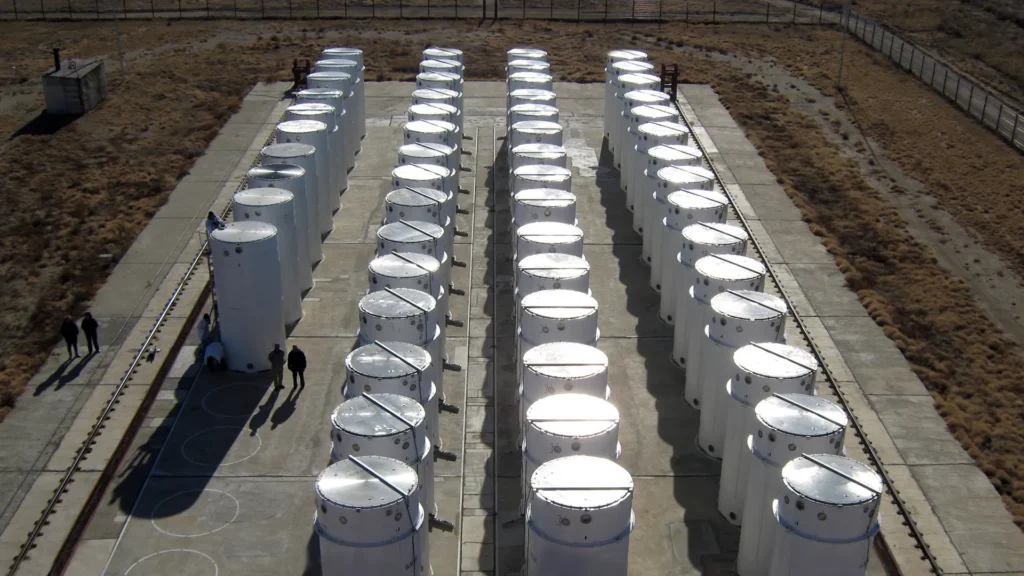Recent reports have reignited one of the most controversial energy debates in decades: whether the United States should repurpose weapons-grade plutonium from its nuclear stockpile to fuel civilian power plants. The proposal, currently under review by the Trump administration, stems from executive orders signed in May 2025 by former President Trump and has already sparked fierce debate among energy experts, lawmakers, and environmental advocates.
What Exactly Is Being Proposed?
According to a draft memo obtained by Reuters in August 2025, the administration is considering making 20 metric tons of Cold War-era plutonium, previously removed from dismantled nuclear warheads, available to U.S. power companies.
A later report from Politico in September 2025 suggested that the proposal could even go further, diverting material that remains part of the active U.S. nuclear weapons program. Under the plan, the Department of Energy (DOE) would alter the plutonium so that it could be safely used in advanced civilian reactors, including those being developed by startup companies in the nuclear energy space.
Participating companies would be responsible for covering the costs of transportation, storage, and the construction of specialized facilities. However, they could receive the plutonium itself at little or no cost, making it a potentially lucrative opportunity for nuclear energy developers.
How Real Is the Proposal?
This isn’t just speculation. The initiative has real policy backing. Trump’s executive orders in May 2025 directed the DOE to pursue this path, and partnerships between the government and private nuclear fuel developers are already underway.
While still in its early stages, the proposal reflects a larger push by the Trump administration to expand nuclear power as part of America’s future energy portfolio.
What Are the Potential Benefits?
Supporters of the proposal argue that it could provide several key advantages:
- Expansion of Nuclear Energy: Nuclear power remains one of the most reliable sources of carbon-free electricity. Repurposing plutonium could fuel advanced reactors and reduce dependence on fossil fuels, aligning with climate goals despite the administration’s inconsistent stance on renewable energy.
- Meeting Energy Demands: With the rise of energy-hungry industries like artificial intelligence (AI) and high-tech manufacturing, demand for reliable baseload power is climbing. A new domestic plutonium fuel source could help meet these demands without increasing greenhouse gas emissions.
- An Alternative to Burial: Currently, surplus plutonium is diluted and buried at the Waste Isolation Pilot Plant (WIPP) in New Mexico, a process the DOE estimates will cost $20 billion. Proponents argue that using the plutonium as fuel could both save money and reduce waste.
What Are the Risks and Concerns?
Critics warn that the risks could outweigh the benefits. Among the most pressing concerns are:
- Nuclear Proliferation Risks: Lawmakers like Senator Edward Markey, along with arms control advocates, caution that handing over weapons-grade plutonium to private companies could undermine global nonproliferation efforts. If the U.S. normalizes civilian use of weapons material, it could set a dangerous precedent for other nations.
- Security Threats: Transporting and handling plutonium—especially in civilian settings—raises concerns about theft, sabotage, or accidents. Weapons-grade material requires strict security protocols, and critics doubt that private companies could maintain them at the same level as the military.
- Impact on the U.S. Weapons Program: Diverting plutonium from the active stockpile could weaken America’s nuclear deterrence capabilities, particularly since the DOE is already behind schedule on producing new plutonium pits for warheads.
- Economic Feasibility: History doesn’t offer much encouragement. A previous DOE project to convert plutonium into mixed-oxide (MOX) fuel ballooned in cost before being canceled in 2018 under Trump’s first administration. Skeptics fear this new effort could repeat those failures.
The Bigger Climate Picture
At the heart of this debate lies a fundamental question: should the U.S. take a gamble on plutonium as a path toward clean, carbon-free power? Nuclear energy is undeniably low in carbon emissions compared to coal and natural gas, but the risks—both environmental and geopolitical—are immense.
As we navigate this turning point, it’s critical to place discussions about plutonium within the broader context of climate action. Long-term sustainable solutions may lie more in renewable technologies, energy storage breakthroughs, and policies that prioritize safety alongside sustainability.
You can explore more about the global fight for climate solutions and the crossroads facing U.S. energy policy in Sustainable Action Now’s Climate Network.
Conclusion
The proposal to use plutonium from U.S. nuclear weapons stockpiles as reactor fuel highlights the tension between innovation, security, and sustainability. Supporters see it as a way to reduce waste, lower costs, and expand nuclear power. Opponents warn of nuclear proliferation, security risks, and economic pitfalls.
As the debate unfolds, one thing is certain: the future of America’s energy mix will shape not just national security and economic growth, but also the global fight against climate change. The choices made today will ripple for generations, making it imperative that policymakers balance ambition with caution, and innovation with responsibility.


